7 Mind-Blowing Projects Where Art Meets Technology
Fine art and science have been closely intertwined since antiquity, which is proven by all-around geniuses like Leonardo da Vinci, whose work blurred...
Guest Author 14 October 2025
With his recognizable style and enigmatic works, Anish Kapoor is one of the most prolific and influential artists of the 21st century. These 5 iconic works summarize his career so far.
Art evokes emotions, challenges perspectives, and transcends boundaries. Some artists, like Anish Kapoor, can harness such potential in just a few touches, with work that blends minimalism and biomorphism in a layered and immersive way, branching out to the outside world, bending and absorbing the surrounding space, capturing viewers’ attention with compact shapes and choice materials.
Kapoor is a minimalist and a maximalist of polished stainless-steel sculptures, mirrors, and public installations. While some of his creations exude pristine perfection, others possess a visceral, fleshy character, made from resins, wax, and other malleable materials as aberrations from his more refined works. This duality in Kapoor’s artistic expression prompts the question: How can an artist express himself in such disparate manners?
Anish Kapoor’s life is as intricate as his artistic production. Born in Mumbai in 1954 to an Iraqi Jewish mother and an Indian Punjabi Hindu father, he spent the first few years in India, attending an all-boys boarding school in Dehradun. In the 1970s, after a short stay in Israel, Kapoor wanted to become a full-time artist and moved to the UK to study first at the Hornsey College of Art (1973–77) and later at the Chelsea School of Art and Design (1977–78). The young artist began to gain a presence through the seminal 1978 New Sculpture exhibition at the Hayward Gallery London, which established his career as a leading artist of his generation.
Since the 1980s, Kapoor has worked his way toward becoming one of the most recognized artists. His work appeared in major exhibitions and biennales, some of which won awards. For example, he represented Great Britain at the Venice Biennale in 1990 and won the Turner Prize in 1991. In September 2009, Kapoor became the first living artist to have a solo exhibition at the Royal Academy of Arts.
Kapoor has lived on two continents. Such an experience shaped his art together with his career trajectory. On the one hand, the saturated pigments prevalent in his work pay homage to his Indian heritage or cultural roots. On the other hand, Kapoor’s attention to the here and now results in two distinct artistic facets. If part of his art still focuses on minimalist shapes, void spaces, and stark contrasts, in recent years, another side of Kapoor’s work has become increasingly present—his wax and resin works, sculptures, and paintings on flesh, blood, and visceral elements—which marks an evolution from the biomorphic shapes on which the artist has invested his whole career.
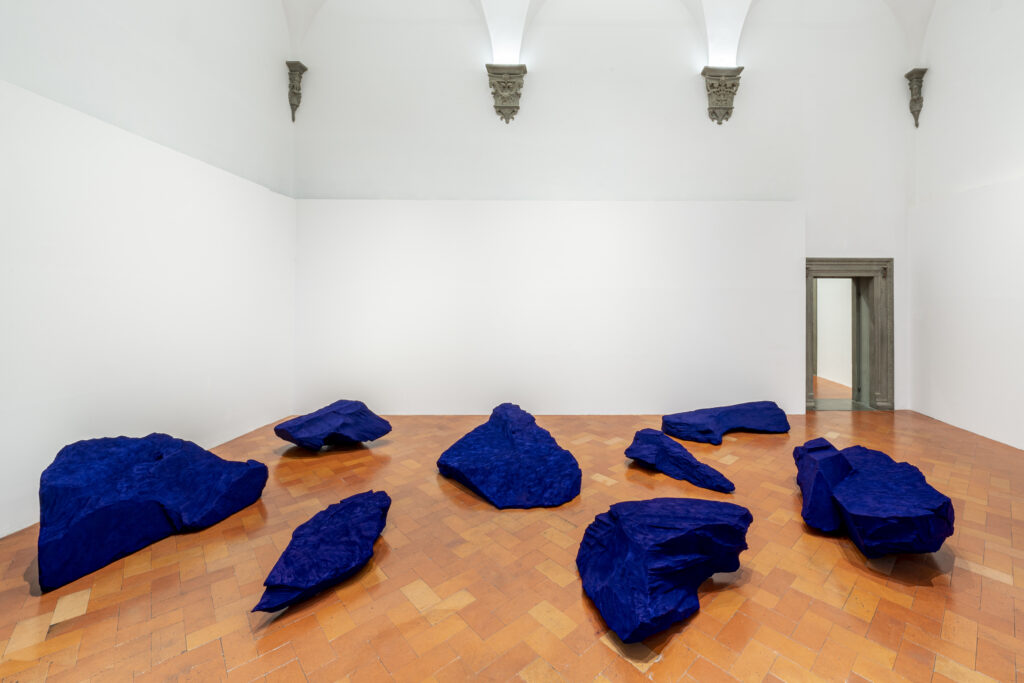
Anish Kapoor, Angel, 1990. Exihibition view at Palazzo Strozzi, Florence, Italy. © Photo ElaBialkowska – OKNOstudio, Courtesy of Palazzo Strozzi.
Among his earlier works, Angel has most of the elements recurrent in Kapoor’s art. The large stones it features are coated with a matte Prussian blue powder pigment. Scattered on the floor, the stones appear soft and weightless as if they are floating in space. This installation depicts things existing despite their nature that will be elaborated by the artist in the years to come, along with the creative use of color and material. In fact, pigments, much like the concept of transformation and transfigurations, are central to Kapoor’s oeuvre. Whether it be the transformation of materials, such as wax or stones, or that of colors, such as the Vantablack pigment, with which Kapoor creates the illusion of void spaces, these creative works convey both mysticism and simplicity. As one of the early expressions, Angel leads the viewer to question what they see. It could be heavy stones, blocks of pigment, or pieces of fallen sky.
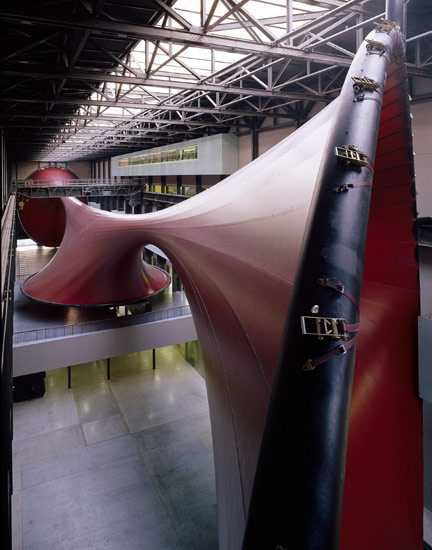
Anish Kapoor, Marsyas, 2002. Installation view at Tate Modern, London, UK. Photograph by Tate Photography.
Created for The Unilever Series of commissions for the Turbine Hall at Tate Modern in London, UK, Marsyas was a gigantic site-specific installation that blurred the boundaries between the space and the work. The concept comes from Marsyas, a satyr in Greek mythology who was flayed alive by Apollo. The work involved only two materials, steel and PVC, and simple forms to invade the entire space of the Turbine Hall.
In line with Kapoor’s exploration of materiality and scale, Marsyas consists of three massive steel rings connected by blood-red PVC membranes stretched between the rings. Kapoor used texture and scale to remind the viewers of different materiality; the color and form stimulate a visceral response and, in turn, contemplation of the relationship between the body and the built environment.
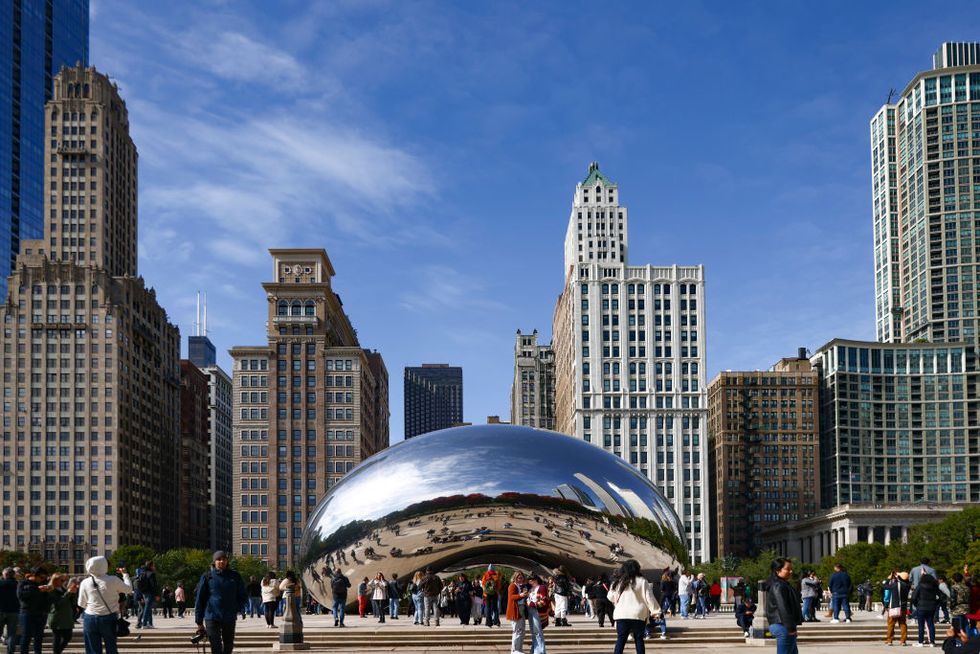
Anish Kapoor, Cloud Gate, 2006, Chicago, IL, USA. Phototograph by NurPhoto/Getty Images. Elle Decor.
Cloud Gate, or commonly The Bean, is a Chicago landmark situated in Millennium Park. This monumental construct welds 168 stainless steel plates together. Meanwhile, its presence reflects and distorts the city’s skyline to engage viewers in a dynamic dialogue with their surroundings. The mirror-like surface draws from liquid mercury but extends the latter’s malleability to a capacity to transform the ordinary into the extraordinary. As a result, the lines between reality and illusion are blurred. The work also took shape from mercury in a way, given how deceivingly amorphous the metal can be. So it endeavors to appear weightless and solid, futuristic and organic all at once as it plays with duality and contrasts.
This is perhaps Kapoor’s most recognizable work and the best-known one from his series of stainless steel and mirror sculptures. Cloud Gate is an invitation to look at the world with a distorted view of reality. How reflection becomes manipulated thus plays a part in reconfiguring our perception of space and the ever-changing nature of our world(s).
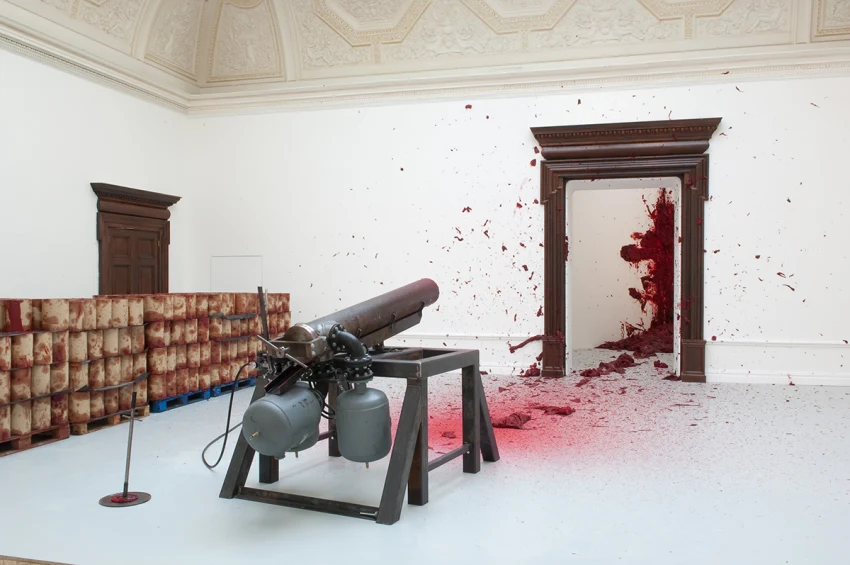
Anish Kapoor, Shooting into the Corner, 2008-2009. Exhibition view at the Royal Academy of Arts, London, UK, 2009. Photograph by Dave Morgan. Museum’s website.
Shooting into the Corner exemplifies Kapoor’s experimental approach. Unlike his polished and minimalistic works, this wax piece is messy, dirty, and utterly human. It utilizes the medium to emulate body parts, blood, and flesh. From another viewpoint, the change of medium and subject matter seems to derive from his previous works, with elements recalling the blood-red PVC of Marsyas but also the organic shapes of Angels.
In this case, though, the installation features a cannon that routinely fires 11 kilograms of red wax pellets into the corner of the gallery space. The accumulation of wax turns the pristine gallery into a living canvas. But this time, it is defined by chance rather than artistic interventions. The result is an eerie artwork if not a macabre sight.
With Shooting into the Corner, Kapoor took the chance to further delve into notions of temporality and transformation his work has been grappling with. Such an installation challenges the conventions of static art. It prompts us viewers to witness the gradual alteration of the space and notice the impermanence of artistic creation. Once again, the art is about duality. It contrasts the heaviness of the cannon with the malleability of the wax, the pristine look of the gallery with the dirt left behind by the pigmented wax, and broadly put, the machine and the organic, which is a contraposition that makes up society by contemporary standards.
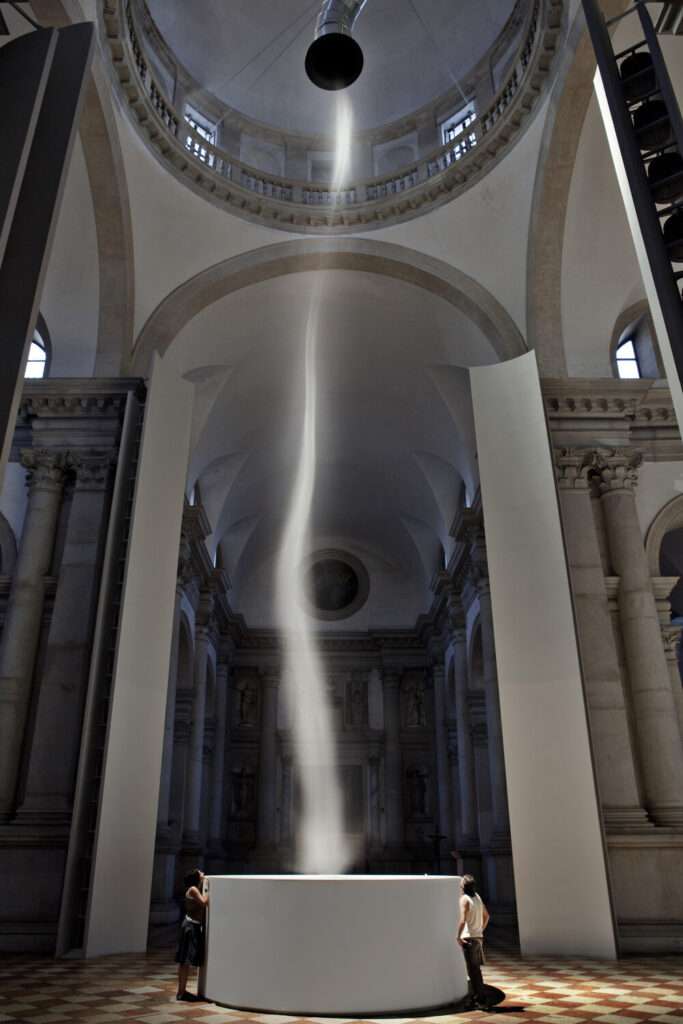
Anish Kapoor, Ascension, 2011, installation view inside the San Giorgio Maggiore, Venice, Italy. Associazione Arte Continua.
After experimenting with mirrors and polished steel, colored wax, PVC, stone slabs, and saturated pigments, Kapoor moved his focus to air and water. His recent work investigates vortexes, both ascending and descending. Reminiscent of the mythic and the mystical, these vortexes further diminish the distinction between form and content. Kapoor champions this creative phase with both minimalistic shapes and layered messages. These artworks are meant to transcend, to literally invade the space they occupy and put it in motion. They are trying not only to alter our perception of said space, but also to bring new significance to its very form and essence.
Ascension, for example, visualizes immateriality and void with a smoke column. This work does not stop at the level of representation as Kapoor’s work previously did, mobilizing a void space, some pigments, and concavity. It attempts to implicate the space, along with its very air and particles, and its movement and dynamism. The work evokes a sense of awe and wonder while challenging the audiences’ sensorium and perceptions. In a similar vein to the “Ascension,” which is a shared experience found in all Christian, Muslim, Jewish, and Buddhist traditions (while each might have a specific expression of it), Kapoor mixes religious elements to create a sense of mystery and sacrality.
DailyArt Magazine needs your support. Every contribution, however big or small, is very valuable for our future. Thanks to it, we will be able to sustain and grow the Magazine. Thank you for your help!